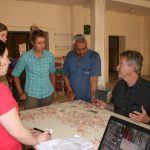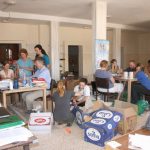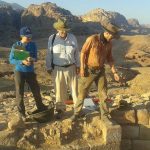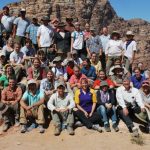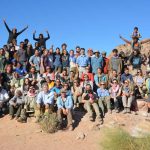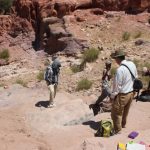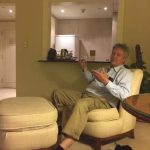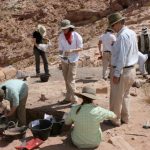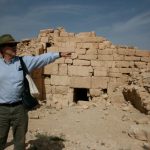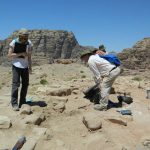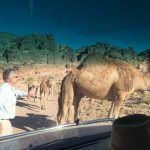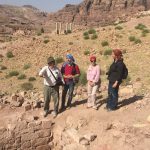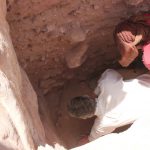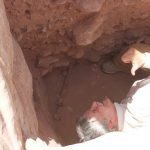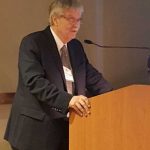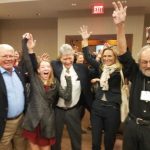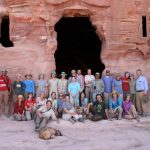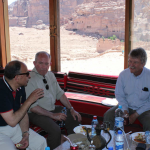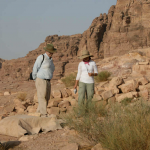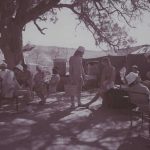
IN MEMORIAM:
S. THOMAS PARKER (1950 – 2021)
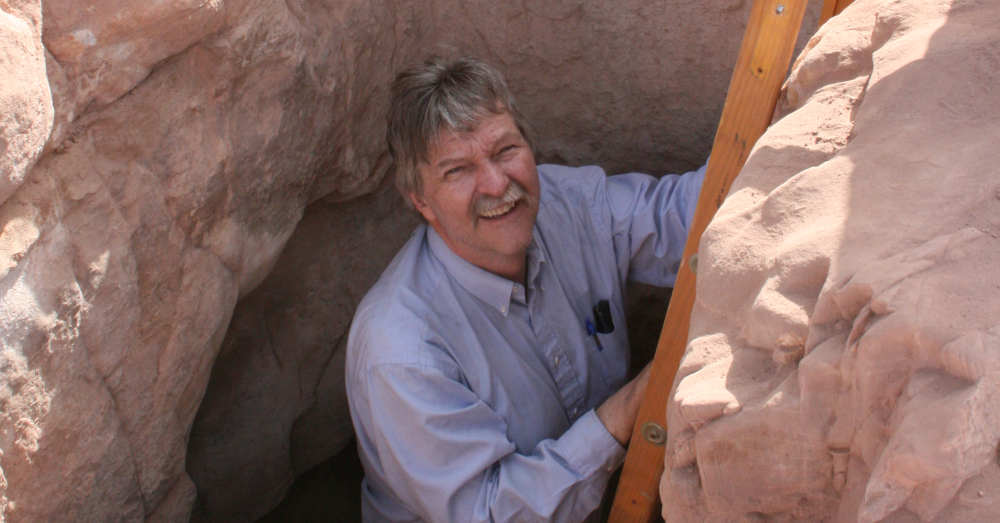
Tom emerging from a Petra North Ridge tomb during the 2012 season. (Photograph by Jennifer Ramsay)
ASOR mourns the passing of long-time member, S. Thomas Parker (1950-2021), who passed away at Duke Hospital in Durham, NC after a brief illness on September 12, at age 71. We share our condolences with Tom’s wife and daughter (Mary Mattocks and Grace Parker), and his siblings.
While we will miss Tom dearly, we remember and celebrate his life and many accomplishments. We have included two remembrances below: a detailed and complete remembrance by Megan Perry, and an additional remembrance by Jeffrey Blakely with additional comments from others.
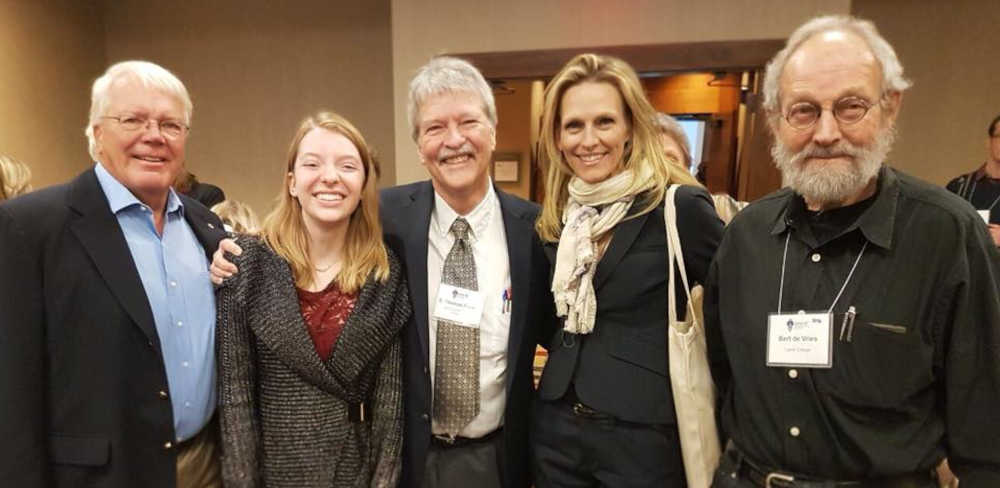
John Oleson, Grace Parker, Tom, Jenna Morton, and Bert deVries after Tom’s Festscrhift session at the 2017 ASOR meeting. (Photograph by Megan Perry)
In Memoriam: S. Thomas Parker (1950 – 2021)
Megan Perry, Professor of Biological Anthropology, East Carolina University
Thomas (Tom) Parker, well-known archaeologist of Roman Jordan and longtime ASOR supporter, passed away suddenly on September 12, 2021. Tom spent most of his childhood in the Chicago area and graduated with his bachelor’s degree in history and religion from Trinity University in 1972. He went on to doctoral studies in history at the University of California, Los Angeles, completing his dissertation in 1979 on his survey of Roman and Byzantine fortifications along the limes Arabicus in Jordan. He joined the History faculty at North Carolina State University in 1980, where he remained throughout his academic career. Tom had almost 50 years of archaeological experience in Jordan, Israel, and Cyprus, having excavated at Tell el-Hesi, Ashkelon, Idalion, Tell Hesban, and the Petra Household Excavations before directing his own field projects. The Tell el-Hesi excavation was a seminal moment for Tom, who not only met many future fellow archaeologists but also began intensively studying ceramic typology that would serve as a major focus for the rest of his career.
Tom directed or co-directed three multi-season excavation projects in Jordan: the Limes Arabicus Project, which expanded his PhD survey to include excavation the legionary fortress of Leijjun, the Roman Aqaba Project, recovering evidence of Nabataean, Roman, and Byzantine Aila, and the Petra North Ridge Project, which I co-directed with Tom. He served as the ceramics specialist on all of his projects, but always with the goal of mentoring students or younger scholars in the field and in the laboratory. His kindness and patience fostered many budding scholars, and he always, always “knew what was best” for them. While many of his students eventually developed careers outside of history and archaeology, their experiences and his unwavering support and pride in their accomplishments profoundly shaped their lives. In turn, many of these former students contributed to a Festscrhift in his honor, published in 2017.
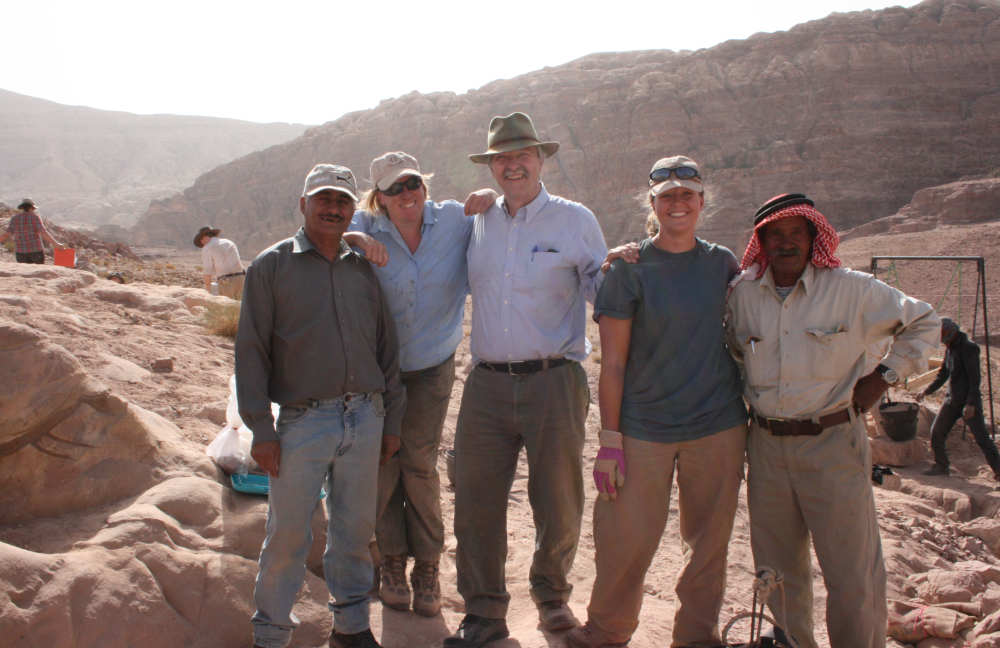
I first met Tom in 1993, when he visited Tell Nimrin to, among other things, meet me as that year’s Groot fellowship recipient. Tom helped established this ACOR fellowship in honor of his dear friend and Leijjun staff member, Jennifer Groot, who sadly died in 1987 at only 36 years of age. Creating this fellowship, which serves to support first-time excavators in Jordan, exemplifies not only Tom’s generosity but also his role as a mentor to young archaeologists. In the weeks since his death, many archaeologists in the region have commented on his support of beginning and even seasoned scholars. Suzanne Richard, director of the Khirbet Iskander project, recalls, “…as a field supervisor at el-Lejjun, I was so impressed with Tom’s expertise in the field, good leadership skills, calm dealings with staff and students, yet he was always vibrant, jolly, and personable.” Tim Harrison, former ASOR director “will always remember the interest he took in what I was doing … His interest and attention, coming from a senior colleague, was a real encouragement…” Monique Roddy, co-director of the Balu’a Regional Archaeological Project, remarks that “Tom was a wonderful mentoring archaeologist, even for those of us who were never his students!”
Tom faithfully supported ACOR and ASOR throughout his career. He served on ACOR’s board since 1987 and had been Second Vice President of the board from 2002 until his death. He also was an ASOR Trustee from 1989-1992 and served on ASOR’s Committee on Archaeological Policy (1986-1987) and on the Editorial Board of BASOR (1995-1998). Tom was someone always “a great person to have on an ASOR Committee,” according to Tom Levy. I first attended the ASOR Annual Meeting in 1995, and I don’t recall a year since then without Tom’s presence at the conference. Deb Foran, director of the Khirbet al-Mukhayyat Project, commented that this is where he will most be missed, for he “always sat in the front row, listened attentively, and asked insightful questions, no matter how senior or junior the speaker was.” This was often preceded by “his characteristic head turn and raise of the hand” once the Q&A period started, followed by “the gentle laughter because everyone knew he was going to have [a question] ready,” recalls his former student Tiffany Key.
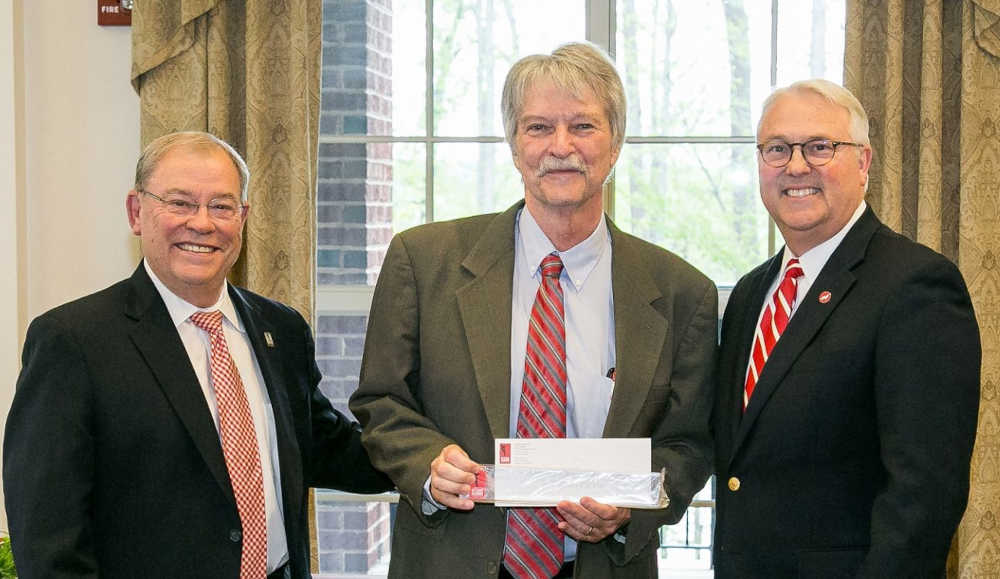
Tom receiving the NC State’s Alumni Association Outstanding Faculty Research Award in 2017. (Photograph by NC State)
Tom will be remembered for his warmth, his conviviality, his support, his mentorship, his friendship, his scholarship, his collaborations, his laughter, and of course, his singing and guitar playing. You know wherever he is, he’s encouraging those around him to join in: “On a dark desert highway, cool wind in my hair…”
Tom is survived by his wife, Mary Mattocks, and their beloved daughter Grace Parker.
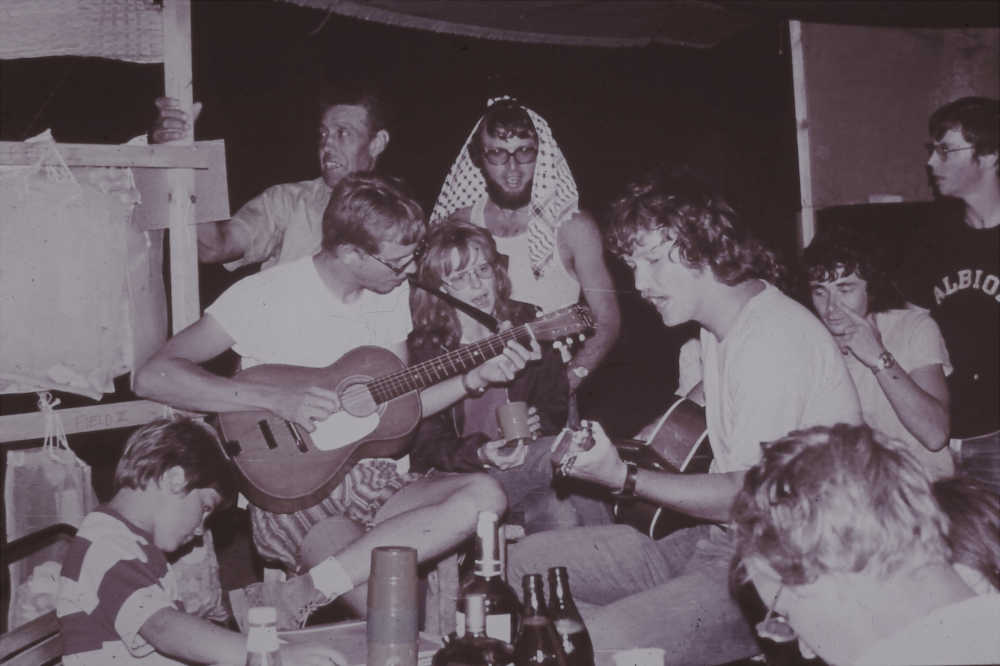
Tom entertaining his fellow Hesi crew. (Photograph by Jeff Blakely)
In Memoriam: S. Thomas Parker (1950 – 2021)
Jeffrey A. Blakely, University of Wisconsin-Madison
Tom and I were friends for just over 50 years, not close friends but good friends who shared a formative experience. In our field, half a century is simply a rounding error, but to friends it is much of our individual lifespans. The day we truly met is as clear to me as yesterday since it was the start of a life altering experience.
Tom and I each decided to participate in the archaeological field school at Tell el-Hesi in the summer of 1971. Soon after the end of the spring semester in early June 1971 we each made our way to the charter flight terminal at Kennedy Airport and boarded a Capital Airways flight for Le Bourget Airport in Paris. A bus tour of Paris and a night in a hotel saw us at Orly the next morning for a flight to Tel Aviv. It was dark when we arrived, boarding busses to our hotels in Jerusalem. After three days of orientation and extensive walking tours of the Holy City we got up and boarded the chartered busses for Hesi. We almost made it, but the drivers refused to cross a wadi so we had to shlep all of our luggage about a half a mile to Hesi’s new tent village. After finding our tents and throwing our luggage in we had to line up for work details since the camp was still a “work in progress.” Sue, the camp manager (and Larry Stager’s wife), “randomly” assigned jobs. Somehow if you were a large or muscular male you were put into one group, twelve guys. I happened to be standing next to Tom and we were paired as a work team. The new camp had not yet dug its outhouses. So we were taken down to six 1.5 x 1.5 meter probes outlined in string and told to keep straight sides and to go down 2.00 meters with picks and hoes. Yella, yella in case they were needed! So at precisely the same time Tom and I began our archaeological experience, digging a modern s****er. We had a number of hours in the hot sun to get to know each other, he from Trinity and me from Oberlin, he just having finished his Junior year and me my Freshman year. He was in history and looking at a potential career in archaeology. I was looking for a once in a lifetime experience. When we reached 2.00m one of the staff came over and noted that our balks were rather overcut … but don’t dare undercut them lest someone sitting on the throne experience a sad and memorable plunge. Once they were straight Larry Toombs hopped in and checked our balks. Below 50 cm of debris/wash we had gone through nothing but loess … no EB city here. Tom and I were friends from that point.
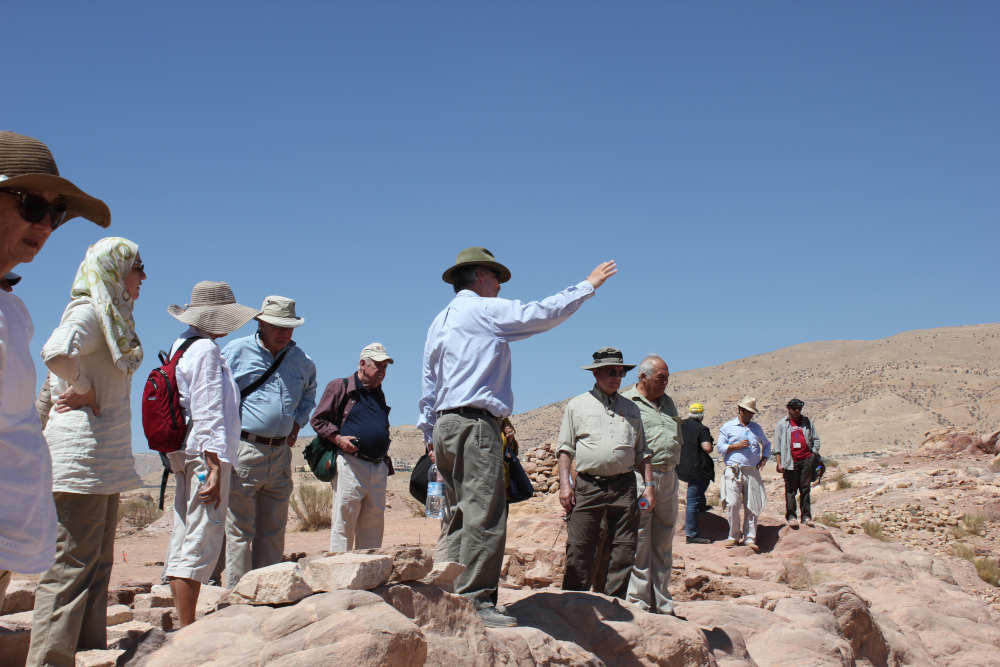
At Camp Hesi the chore details were daily experiences. Soon the botanist had me sorting things and others were pulled off for other recurring duties, but a core four remained unassigned, “Pope, Parker, Woodruff, and Zipris.” Somehow “randomly” Camp Manager Sue always assigned them to the crappiest jobs every day. It became a running joke around camp. In later years when Tom told the story he tended to exaggerate a bit, to wit: “the urinal is filthy, oh, we have no brushes so lick it clean”, or “the outhouses are mounding in the middle, so jump in and push the pile to the sides as you distribute the lime”, or, “I can’t think of a task so dig a big hole and then refill it.” Tom certainly got the short end here, but it was not quite as extreme as his story. Good story, though!
In 1971 Tom was assigned to a square in Field III, while I was in Field I. We both learned a lot and at the end of the season we headed back to college. By 1973 Tom was in Grad school in History and Archaeology at UCLA and I was a Junior at Oberlin. He had successfully applied to be an Area Supervisor while I had wanted to come back and dig again, but I received a field promotion so I, too, became an Area Supervisor. Tom remained in Field III digging the Iron Age fortification system and I remained in Field I digging Persian-Period pits and floors, both in 1973 and 1975. We learned how to dig and how to supervise. It served us well. Tom was also the co-writer and lead performer of the classic Hesi song “Big Mama Sift Some More” and the “permanent” host of the end of the dig parties. By 1977 he was doing his own research in Jordan. But, forever, he was a Hesi-ite at heart. He always came to the Hesi sessions at ASOR and he always would find time to sit and talk with me. His advice was always thoughtful and valued. He was a true friend of mine and of the project.
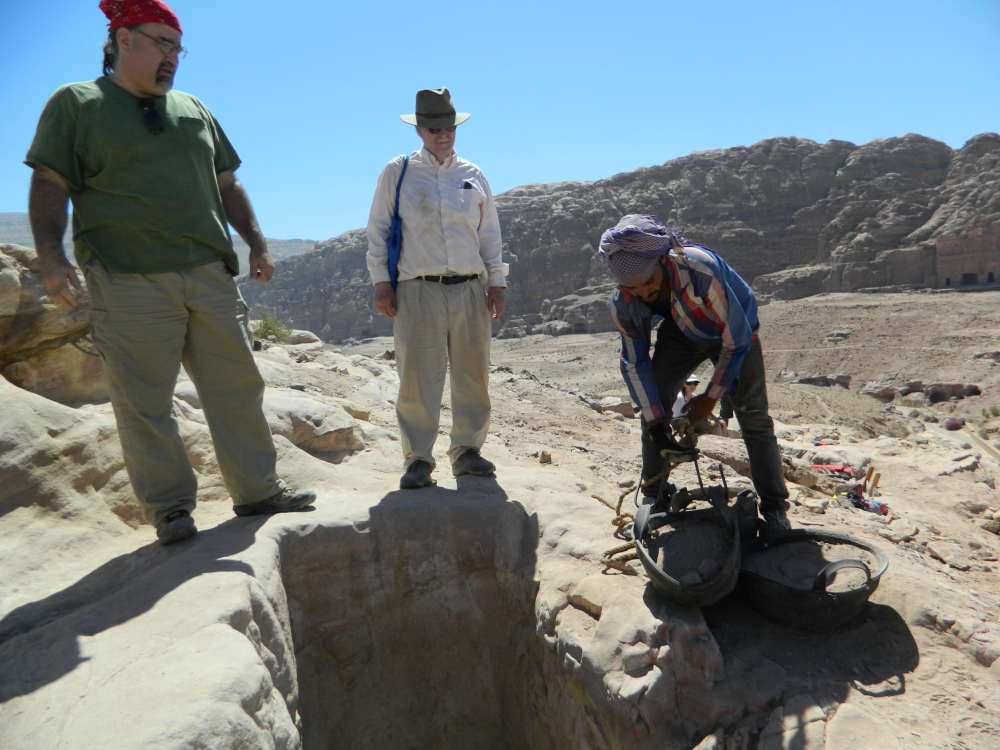
In 1996 my family and I were to spend a year in Jerusalem, and I came over early to set up school and other things for our son. In advance of this I contacted Tom. We had been friends for 25 years and in the summer of 1996 I was not doing my own research. So, I asked, can I pay my own way and come and simply dig and once again experience what drew me to the field? Tom was the only person I would ever want to work with in such a way … afterall, we were the only Hesi-ites running projects. Tom said, sure, but wouldn’t I rather supervise? No, no responsibilities, let me relive the joys of fieldwork again. Okay.
In late May 1996 after a day in the hot sun crossing the border from Elat to Aqaba I arrived at the project headquarters and I found the proper floor. I saw Tom down the hall and he motioned to me to come and talk in his room as soon as I dropped my bags in my room. I joined him and he had a grim face and he told me he had a big problem. One of his supervisors cancelled at the last minute and even though we had agreed I was to be a digger, could I supervise instead? Damn, I said sure I can do an Area, on a dig you do what is needed. But then he said, “No, you misunderstand” … it was one of the Field Supervisors and I would be overseeing six Areas; remember you just said you do what is needed. Somehow I think I fell into a well orchestrated plan, and a few years later when I actually asked if that was the case, all I got was a typical Tom Parker smile and a helpless shrug. I will always see that smile and shrug when I think of Tom.
Jeff Blakely
Comments in Remembrance of Tom Parker
“I will always remember the interest he took in what I was doing, even if it involved cultural periods much earlier than his own research focus… His interest and attention, coming from a senior colleague, was a real encouragement, and modelled a wonderful collegiality that continued over many years.” – Tim Harrison
“Even in 1980, as a field supervisor at el-Lejjun, I was so impressed with Tom’s expertise in the field, good leaderships skills, calm dealings with staff and students, yet he was always vibrant, jolly, and personable. He became a leader in the field but was still the same wonderful Tom.” – Suzanne Richard
“From the first time we met and worked together (1976 at Tall Hisban), I could see in him a rising star in the field. From my point of view, his star has set much too soon. We will miss him.” – Doug Clark
“The study of the archaeology of Jordan and the Roman Near East will not be the same without Tom Parker, nor will ACOR. Those of us in the field have lost such a warm, gregarious, vivacious, and endlessly supportive colleague.” – Elise Friedland
“Tom was the first ‘real’ archeologist that I met in Jordan (35 years ago) – he was so unpretentious, humble, full of humor – in one word: a ‘Kumpel’! – and yet: a world class scholar.” – Friedbert Ninow
“Thomas Parker was to me Sir Thomas Parker, a world-class scholar, an enthusiastic and charismatic field archaeologist, a great teacher and mentor, and a loyal and most enjoyable companion, fellow camper and friend… His scholarly achievements as an archaeologist of the Roman Frontier in the Southern Levant will be re-visited over and over again by future generations for decades to come.” – Øystein LaBianca
“Working in Jordan will never be the same without them both [Tom and Bert deVries, who passed away in March of this year]. We will miss their presence at every ASOR Conference and at every group meal at ACOR. They were both such amazing mentors and willing to help scholars of all ages and backgrounds. God grant comfort to Tom’s family and may his legacy live on in every young scholar and colleague that we each can assist and encourage just like Tom did.” – Cynthia Finlayson
“From my first interaction with Tom in the late 1980’s I was thankful of his presence, his humanity and his love of archaeology. Really, this is a major loss.” – Ian Kuijt
“Tom was the friendliest, most supportive colleague, and a great mentor. We will all miss him.” – Jonathan Ferguson
“Tom and I cross over more than 4 decades as active members of the Jordanian archaeological community, our mutual interest in Roman Frontier Studies, and our excavations at Petra. A great personal loss for me and for everyone. The epitome of an ambassador for our profession.” – David Graf
“I’ll never forget when we gave him his start in Jordanian archaeology as a field supervisor at Hisban in 1974…. For the last fifty years he’s been at the forefront of Jordanian archaeology and has touched the lives for good of all of us.” – Larry Geraty
“This is indeed a tremendous loss for us all. My deepest sympathies to his family. I will miss him greatly.” – Lisa Maher
“Tom was the biggest advocate of junior archaeologists and always had a smile on his face. He will be missed.” – Leigh-Ann Bedal
“A tremendous loss to his family, his friends, his students, and to archaeology in Jordan. It’s difficult to imagine Jordan without the presence and contributions of Tom Parker.” – Gary Rollefson
“He was such a nice person and a good scholar… It is difficult to think on works and not having him somwehere in the back as advisor and friendly colleague.” – Robert Wenning
“Tom, a gentleman and collaborator in support of ACOR’s vision, supported the institution by serving on many of the board’s committees, and always calmly responded to its challenges. Tom also nurtured camaraderie with everyone he met. Always thoughtful and encouraging. Tom threw great parties. Tom’s scholarship was impeccable.” – Martha Joukowsky via her daughter Nina Köprülü
“The flood of recollections and condolences reflect the place Tom held in the ASOR/ACOR community. STP was one of a kind, and we’ve suffered a great loss at many levels.” – Jerry & Pam Mattingly
“Everyone who knew Tom will miss him. He was a great scholar and a friend of many Jordanians. May his soul Rest In Peace.” – Moawiyah Ibrahim
“…he was a friend and colleague going back to 1975 when we first went to Jordan, and one of my daughters was a member on his digs…a strong supporter of ACOR both in his financial support and the time and effort he put into the fellowship program. We will miss him significantly and condolences to his family.” – Randy Old
“Tom was such a kind, funny, and supportive figure, and I have long admired his dedication to good and careful scholarship, his encouragement to younger scholars, and his commitment to Jordan. I’m grateful that I had the chance to get to know him.” – Björn Anderson
“Tom was a unique individual, a good friend to just about everyone he met, and he leaves a big gap in all sorts of places, most of all in our hearts.” – John Oleson
“It is a big loss to ACOR and to the field in Jordan. I also feel lucky to have got to know him over the 4+ years I have been on the ACOR board and I am grateful for that.” – David Nichols
“Tom was not only a wonderful mentor and colleague but also a true friend, working in Jordan and attending ASOR meetings will not be the same. I count myself lucky to have had the opportunity to have learned from him and worked with him in the field. He will be truly missed by everyone who knew him and my heart goes out to his family.” – Jennifer Ramsay
“In our years at ACOR, Tom was very helpful to us in many ways. His work on the fellowship committee always led to ACOR having interesting and committed scholars. Tom was also a good colleague, ever generous with his expertise. We will miss him.” – Pierre and Patricia Bikai
“Tom Parker was a special person, and not just an amazing scholar, teacher, and leader. I will always be grateful for the ways that he supported me in my work and encouraged me a person. Neither ACOR nor ASOR would be the strong organizations that they are today without him..” – Andy Vaughn
Image Gallery
An ACOR Fellowship – the “S. Thomas Parker ACOR Memorial Fellowship” – is being established in Tom’s memory. The link below will direct you to his page. This fellowship will support students participating on archaeological projects and doing research in Jordan, continuing the tradition of mentorship so important to Tom.
https://acorjordan.org/contributions-in-honor-of-s-thomas-parker/
American Society of Overseas Research
The James F. Strange Center
209 Commerce Street
Alexandria, VA 22314
E-mail: info@asor.org
© 2023 ASOR
All rights reserved.
Images licensed under a Creative Commons Attribution-NonCommercial-ShareAlike 4.0 International License
COVID-19 Update: Please consider making payments or gifts on our secure Online Portal. Please e-mail info@asor.org if you have questions or need help.
